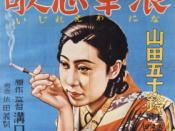Cinema was first introduced to Japan in 1896 when the Kinetoscope, invented by Thomas Edison three years earlier, was imported to Kobe. The first public showing of a film was held on 25 November. This was soon followed by showings in Osaka, Tokyo and the rest of Japan. In February 1897, the Cinematographe, invented by the Lumiere brothers, was imported to Kobe. Due to technical difficulties concerning the installation of electrical equipment, the first showing could not be held until February 15 when it was shown in Osaka. However, on the 16th the theater was full of people eager to see the new invention.
During the first two decades after cinema was introduced to Japan, it was considered to be an object of curiosity and was billed as a rare Western invention. Although each film was only two or three minutes long, the show began with an introduction of the new invention and the film to be projected, and the live musical accompaniment made for an exciting event.
It was rare that films were shown for more than a week at a time in any one hall. Afterwards they would be shown at locations in the surrounding countryside areas. As a result of this limited run, it was not practical to establish any permanent cinemas solely for the purpose of showing films.
One of the first Japanese companies that became involved in cinema was Yoshizawa. As early as the year 1902 it imported enough films from the West to allow for up to two months of showings at one location. This helped pave the way for the opening of Japan's first permanent cinema in October 1903. The Denkikan, an X-ray clinic in the Tokyo entertainment quarter of Asakusa, was equipped with projection facilities. This was followed by the opening...


